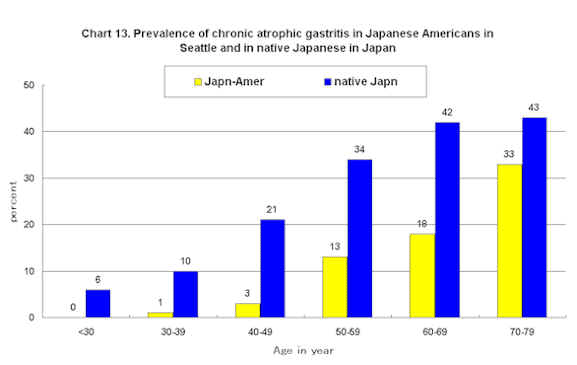Stomach Cancer Research Program
Stomach cancer remains the second leading cause of cancer death worldwide. The highest rates of stomach cancer are found in Japan and Chile, and one of the lowest rates is in the United States. However, stomach cancer appears more frequently in Japanese Americans than in European Americans. New cases of stomach cancer are found in 28/100,000 persons among Japanese Americans.
In 1996, DPC launched a stomach cancer study in collaboration with Professor Kazumasa Miki of Toho University and Professors Michael Kimmey and Thomas Fritsche of the University of Washington. The study participants were about 800 Japanese American adults in the Seattle area. The purpose of the study is to identify risk factors associated with chronic atrophic gastritis, a condition considered to somewhat increase the likelihood of developing stomach cancer.
To screen persons with chronic atrophic gastritis, Prof. Miki measured blood levels of pepsinogens (an enzyme of precursor of pepsin); low levels are associated with chronic atrophic gastritis. Test kits for pepsinogen are commercially available in Japan but not in the United States. Age-specific prevalence rates for chronic atrophic gastritis are consistently lower for Japanese Americans than for native Japanese, implying that environmental factors play a significant role in stomach cancer.

Chart13. Prevalence of chronic atrophic gastritis among native Japanese and Japanese Americans. Data were based on 840 Japanese in Seattle and 25,415 native Japanese in Japan who participated in health screenings.
Stomach cancer is associated with dietary factors such as a high intake of salt and pickled or smoked foods, and a low intake of fresh fruits and vegetables. More recently, researchers have examined the role of Helicobacter pylori, which lives in the stomach for decades and probably causes peptic ulcer and chronic atrophic gastritis. Our preliminary findings show that prevalence rates of H. pylori and chronic atrophic gastritis increase with age, and that living in Japan for more than 20 years and having H. pylori infection synergistically increase the risk for chronic atrophic gastritis. All participants with abnormally low pepsinogen levels have been offered an endoscopic examination at the University of Washington Medical Center. This examination can detect some cancers at early stage and thereby the tumor can be removed.
Publications and Presentations
- Chronic atrophic gastritis and Helicobacter pylori infection among Japanese Americans in Seattle.
- Helicobacter Pylori Infection and Chronic Atrophic Gastritis among Asian Immigrants in the Seattle Area, U.S.A.
Namekata T, Miki K, Kimmey M, Fritsche T, Hughes D, Moore D, Suzuki K. Chronic atrophic gastritis and Helicobacter pylori infection among Japanese Americans in Seattle. American Journal of Epidemiology 2000; 151:820-30.